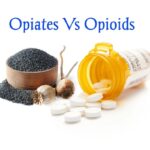What Are Opioids? History, Classes, Examples, Effects

What are opioids?
Opioids are a class of drugs naturally found in the opium poppy plant and that work in the brain to produce a variety of effects, including the relief of pain with many of these drugs. The term “opioids” also include compounds with similar properties that can interact with opioid receptors in the brain. Opioids have analgesic and sedative effects, and are commonly used for the management of pain.
After intake, opioids can cause euphoria, which is one of the main reasons why they are taken for non-medical reasons. Their regular non-medical use, prolonged use, misuse and use without medical supervision can lead to opioid dependence and other health problems. Opioid dependence is a disorder of regulation of opioid use arising from repeated or continuous use of opioids. The characteristic feature of dependence is a strong internal drive to use opioids, which manifests itself by impaired ability to control use, increasing priority given to use over other activities and persistence of use despite harm or negative consequences
History of opioids
It is hard to decide when and where the opium poppy was first cultivated. It may have been grown for its seeds before people discovered how to prepare mekonion from the leaves and fruits of the plant or opium (from “opos,” the Greek word for juice) from the liquid that appears on the unripe seed capsule when it is notched.
Opium has been known for millennia to relieve pain and its use for surgical analgesia has been recorded for several centuries. The Sumerian clay tablet (about 2100 BC) is considered to be the world’s oldest recorded list of medical prescriptions. It is believed by some scholars that the opium poppy is referred to on the tablet. Some objects from the ancient Greek Minoan culture may also suggest the knowledge of the poppy.
The first authentic reference to the milky juice of the poppy was by Theophrastus at the beginning of the third century BC. In the first century the opium poppy and opium was known by Dioscorides, Pliny and Celsus and later on by Galen. Celsus suggests the use of opium before surgery and Dioscorides recommended that patients should take mandrake (contains scopolamine and atropine) mixed with wine, before limb amputation. The Arabic physicians used opium very extensively and about 1000 AD it was recommended by Avicenna especially in diarrhoea and diseases of the eye.
In the early 1800s, sciences developed and Sertürner isolated morphine from opium and was the founder of alkaloid research. A more safe and standardized effect was obtained by the pure opium. Several morphine-like drugs have been synthesized to minimize adverse effects and abuse potential. Opioid receptors were identified and characterized in binding assays and their localization examined.
What are the classes of opioids?
Opioids are defined by their ability to bind to and influence opiate receptors on cell membranes. They can be divided into 3 classes:
Naturally occurring opioids: The following 6 opium alkaloids occur naturally: morphine, narcotine, codeine, thebaine, papaverine and narceine. Opium is extracted from the plant Papaver somniferum (the opium poppy), and morphine is the primary active component of opium. Endogenous neural polypeptides such as endorphins and enkephalins are also natural opioids.
Semi-synthetic opioids: Semisynthesis is a type of chemical synthesis that uses compounds isolated from natural sources (eg, plants) as starting materials. Examples of semi-synthetic opioids include: heroin, oxycodone, oxymorphone, and hydrocodone.
Synthetic opioids: Synthetic opioids are made using total synthesis, in which large molecules are synthesized from a stepwise combination of small and inexpensive (petrochemical) building blocks. Examples of synthetic opioids include buprenorphine, methadone, fentanyl, alfentanil, levorphanol, meperidine, and propoxyphene (withdrawn from US market).
.
| Naturally occurring compounds | Semi-synthetic compounds | Synthetic compounds |
| Morphine | Diamorphine (heroin) | Pethidine |
| Codeine | Dihydromorphone | Fentanyl |
| Thebaine | Buprenorphine | Methadone |
| Papaverine | Oxycodone | Alfentanil |
| Remifentanil | ||
| Tapentadol |
Opioids Vs Opiates
The term “opioid” is used traditionally to refer to the synthetic and semi-synthetic drugs in this class, while “opiate” traditionally refers to opium alkaloids, or the natural derivatives. But according to The National Alliance of Advocates for Buprenorphine Treatment, the term “opioid” has recently come to apply to all opioids and opiates. The National Institute on Drug Abuse also classifies all of the drugs that act on opiate receptors as “opioids,” regardless of how they’re produced.
What are the medical uses of opioids?
Analgesia: Opioid analgesics appear to be most effective in treating or managing severe constant pain and are often used in the management of pain in cancer patients or in those with pain associated with other terminal illnesses. Opioid analgesics are also often used during obstetric labor; however, because opioids cross the placental barrier and reach the fetus, care and caution must be implemented to minimize the incidence of neonatal depression. In addition, opioid analgesics are often employed for the acute, severe pain associated with renal and biliary colic and often require the use of a strong opioid agonist.
Acute Pulmonary Edema: The use of intravenous morphine provides relief of dyspnea from pulmonary edema associated with left ventricular failure. Mechanisms of action include; reduced awareness of shortness of breath, decreased anxiety levels in patients, and reduced cardiac preload and afterload.
Diarrhea: Opioids from the phenylpiperidine subclass of opioids, which consists of synhthetic opiates, are often used to control diarrhea due to their selective GI effects. Examples of these agents include diphenoxylate and loperamide.
Cough: Cough suppression can be achieved at doses lower than required for analgesia; however, the use of opioid analgesics for cough suppression has decreased due to the formulation of newer agents, which are nonanalgesic and nonaddictive synthetic agents. The opioid derivatives most commonly used as antitussives include dextromethophan and codeine.
Anesthesia: Opioids are frequently used as premedicant drugs before anesthesia and surgery because of their sedative, anxiolytic, and analgesic properties. In addition, these agents are used intraoperatively both as adjunctive therapy and in high doses as a major component of the anesthetic protocol. Opioids are often used as regional analgesics and administered into the epidural or subarachnoid spaces of the spinal cord. Opioids are also commonly utilized during cardiac and other types of high risk surgery to minimize cardiovascular depression.
What are the side effects of opioids?
Adverse effects associated with opioids include constipation, nausea, vomiting, urinary retention, sedation, impaired cognition, behavioral restlessness, pruritus, miosis, respiratory depression, and postural hypotension.
The most common of these adverse effects include:
- Constipation
- Sedation
- Nausea
- Vomiting and pruritus.







One Comment